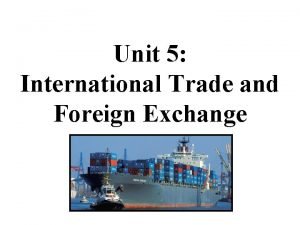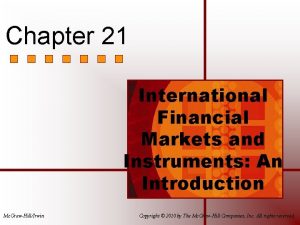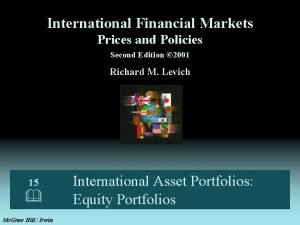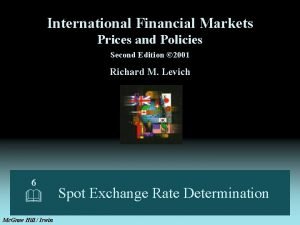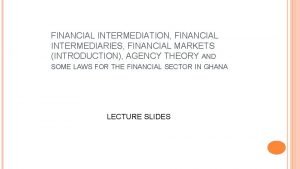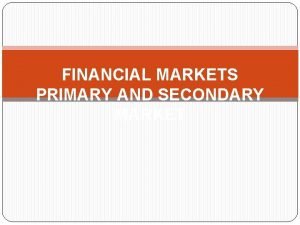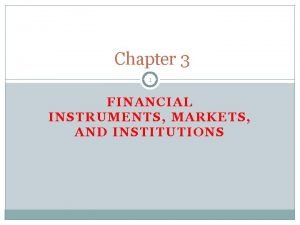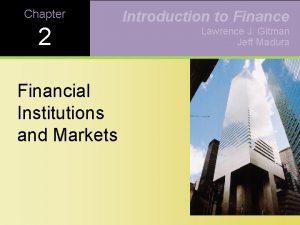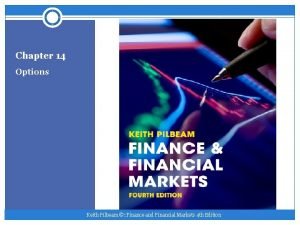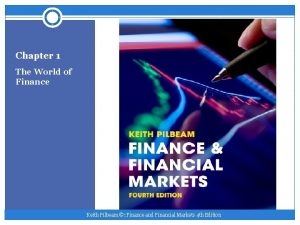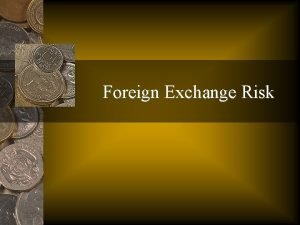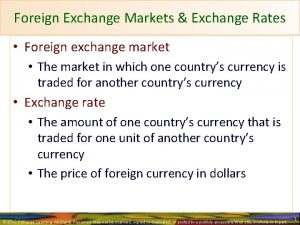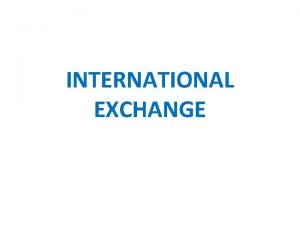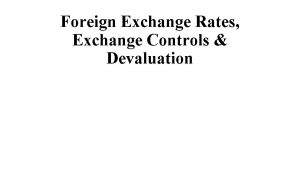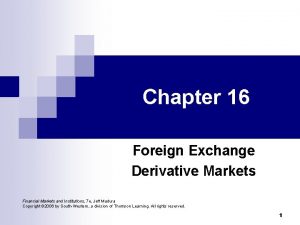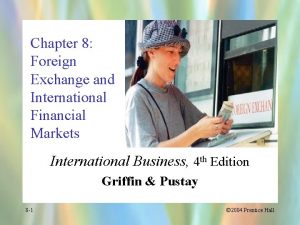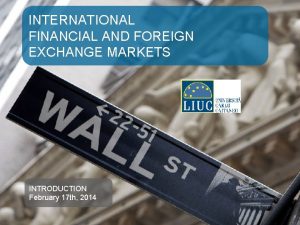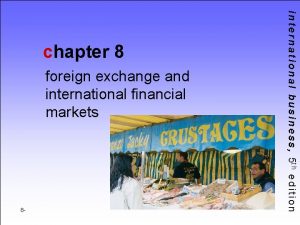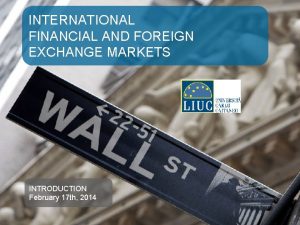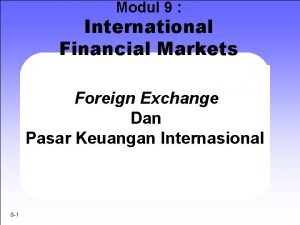International Financial and Foreign Exchange Markets A Y


















- Slides: 18

International Financial and Foreign Exchange Markets A. Y. 2013 - 2014 Giuseppe Schlitzer (Head of the course), Arianna Ziliotto (Lecturer) 1

Overview 1. 2. 3. 4. 5. 6. 7. 8. Aims of the course Course Delivery Readings Grading Syllabus Prerequisites Office Hours and E-mail Addresses About the Instructors 2

Aims of the course 1. Understanding the mechanics and the economic rationale behind foreign exchange markets. 2. Mastering the basic principles of international portfolio diversification. 3. Gaining an insight about many current crucial issues concerning international financial markets. Developing a deeper understanding of their likely impact on the global economy. 3

Course delivery I The course revolves around a continuous blend between the macroeconomics and the microeconomics of international financial markets, while shedding light on daily FX market functioning and trading mechanisms. 4

Course delivery II The course will extensively combine theory and practice, with a twofold aim: Developing a sound theoretical background Mastering the basic principles of market trading and understanding current economic and financial issues on a worldwide scale 5

Readings Textbook: International Finance, M. D. Levi, 5 th edition 2009, Routledge Slides and additional material provided throughout the course (available on my. liuc. it) 6

Grading I • Attending students: closed book exam. The final grade will be marked up (extra points for attendance) for all the students attending at least 12 classes out of 15 • Non attending students: closed book exam 7

Grading II If so desired by the student, the final grade may be revised (upwards/ downwards) by sitting an additional oral examination to be carried out right before the exam’s registration 8

Grading III Minimum passing grade for the written examination (excluding the additional points for attendance): 18/30. Please, note that this is also a necessary requirement to be admitted to the final oral exam. 9

Extra points for attendance Attending students will get: • 3 extra points, if they sit the final exam by the end of June 2014; • 2 points, if they sit the final examination by the end of July 2014; • 1 point, if they sit the final exam by the end of September 2014. 10

The sooner, the better… 45% Final Score ≥ 26 (A. Y. 2012 -2013) 40% 35% 30% 25% 20% 15% 10% 5% 0% 27 May 2013 17 June 2013 01 July 2013 02 Sept 2013 11

Syllabus I Detailed schedule available on my. liuc. it 1. International financial markets and the global economy; 2. The infrastructure of international finance: from the gold standard to the current economic and financial crisis; 3. Focus on FX market dynamics: quoting conventions, traded instruments, settlement procedures and non-arbitrage relationships; 12

Syllabus II 4. Exchange rate parity conditions and their empirical relevance; 5. Bo. P accounting and models of foreign exchange rate determination; 6. Risks, exposures and hedging techniques in an international environment; 7. FX markets efficiency and exchange rate forecasting; 8. International portfolio diversification. 13

Prerequisites Though NOT strictly required, a sound background in International Economics is warmly recommended. Some preliminary knowledge of Market Finance and Derivative Instruments will also be of great help. 14

Office hours (Prof. Schlitzer) When: 24 th March, 07 th May, 19 th May, from 14. 30 to 15. 30 p. m. Where: Lecture Hall How: (On request) E-mail confirmation 15

Office hours (Prof. Ziliotto) When: Mondays from 18. 30 to 19. 30 p. m. Where: Lecture Hall How: E-mail confirmation 16

Mail & Info gschlitzer@aitecweb. com aziliotto@liuc. it 17

About the Instructors Giuseppe Schlitzer (MPhil Economics, 1998, George Washington University; MA Economics, 1990, University of Chicago; B. Sc. Economics and Business, 1986, Università degli Studi di Napoli “Federico II”) is General Manager and CEO at AITEC (Associazione Italiana Tecnico Economica del Cemento). He previously held senior positions at the IMF, at Confindustria as well as at the Central Bank of Italy. His main research interests cover the fields of Monetary Economics and International Economics and Business. Arianna Ziliotto (Ph. D, 2012, Universita’ Cattaneo – LIUC, Master Degree in Corporate and Market Finance, 2009, Universita’ Cattaneo – LIUC) is Risk Manager at Method Investments and Advisory Ltd. She previously worked as Derivatives and Fixed Income trader. Her main research interests cover the fields of Quantitative Finance and Financial Markets Efficiency. 18
 Foreign exchange and international financial markets
Foreign exchange and international financial markets International trade and foreign exchange
International trade and foreign exchange International financial markets and instruments
International financial markets and instruments Levich international financial markets
Levich international financial markets International financial markets levich
International financial markets levich When entering foreign markets basic entry
When entering foreign markets basic entry Entering foreign markets
Entering foreign markets Here you are too foreign for home
Here you are too foreign for home Why study financial markets and institutions?
Why study financial markets and institutions? Financial intermediaries ppt
Financial intermediaries ppt Financial markets and institutions ppt
Financial markets and institutions ppt Financial intermediary
Financial intermediary Savers and investors role in financial markets
Savers and investors role in financial markets Methods of floatation in primary market
Methods of floatation in primary market Efficient capital allocation
Efficient capital allocation Basic flow of funds through the financial system
Basic flow of funds through the financial system Madura j. financial markets and institutions
Madura j. financial markets and institutions Pilbeam k. finance and financial markets
Pilbeam k. finance and financial markets Finance and financial markets keith pilbeam
Finance and financial markets keith pilbeam

